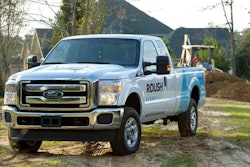
Your pickup has air-helper springs installed to help keep it level when a heavy load is in the bed. They work great.
But what adjustments do you make when a big trailer is dropped on the hitch ball?
Do you inflate the air-helper springs and a install a weight-distributing hitch to get the truck properly set up for towing?
Or, do you even need a weight-distributing hitch at all?
Can’t you just air up the bags to level the truck?
Those were the questions a contractor friend posed to me the other day.
He uses his 1/2-ton truck during the work week to haul fuel drums and machine parts in the bed, while occasionally towing equipment and box trailers that weigh less than 5,000 pounds to different jobsites.
 Air-helper springs don’t change the fulcrum point, which is over the rear axle. They just raise the fulcrum point height.
Air-helper springs don’t change the fulcrum point, which is over the rear axle. They just raise the fulcrum point height.When those loads are in play, he uses a remote control to inflate the air-bags to bring his pickup back to level ride-height.
But on the weekends he hitches up a 7,500-pound RV trailer and heads out for some quality family time.
His dilemma is figuring out the optimum air pressure to use in the air-helper springs when towing the travel trailer with the W-D hitch.
I had my idea, but wanted to confer with the manufacturers of air-helper springs, w-d hitches, and the pickup manufacturers before offering him this advice:
Drop the air pressure in the bags to their minimum amount. Then adjust the weight-distributing hitch so it evenly distributes the trailer’s heavy tongue-weight across the front and rear axles of truck.
Airing-up the “helper springs” doesn’t change the lever-type action that tongue-weight plays in lifting the truck’s front suspension when it rolls through dips and over rises with a heavy trailer in-tow.
A weight-distributing hitch, on the other hand, keeps that suspension-upsetting action in check by keeping those sudden changes in weight distribution muted and the truck in control.
Trying to use the air-helper springs for added weight support while using a weight-distributing hitch will only create more handling issues.










